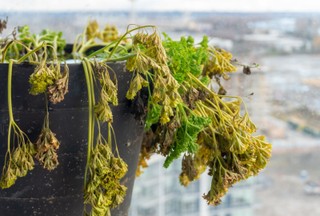8 Reasons why your indoor herbs are dying and how to fix it

You’ve made the leap from dreaming of an indoor herb garden to growing potted herbs on the windowsill, and then one day things start going downhill. If your sage seems sad and your dill is droopy, it has nothing to do with the color of your thumb. Herbs need certain things, and yours aren’t getting them.
If your herb gardening efforts are taking a turn for the worse, read the following reasons why potted herbs fail, then follow the gardening tips given to fix them. With a little TLC, your favorite herbs will be tip-top in no time.
1. You’ve got drainage or water problems
Unlike outdoor plants, houseplants are at your mercy when it comes to water and drainage. Pay attention to your plant’s leaves. If they look wilted, press a finger into the soil a couple of inches to see if it is dry. Water only when the soil surface is dry, and see how your fresh herbs perk up immediately. Pick up pots that are freshly watered to get a feel for their weight. If a pot feels light, the soil is probably dry and ready for watering.
Overwatering is the cause of far more plant deaths than under-watering. The culprit is often that beginners want adorable container gardens and end up using containers without drainage. Many google results will tell you to put gravel in the bottom of containers that don’t have drainage. Don’t do this, it won’t help at all, and your plants will still die a slow death by drowning. Root systems need air, and when they don’t get it, they rot and die. If your soil is saturated and even a tiny bit stinky like a rotten egg, you need to get that plant out of there, fast!
If your heart is set on a ceramic teapot planter, there’s hope. You’ll need an electric drill and a masonry bit, preferably 1/4 inch or smaller. Take your time and drill several holes in the bottom of the container, and voila!–you’ve got drainage. The good news is that you can do this with any container, just make sure you use a drill bit designed for the material the container is made of. And don’t forget to put something under the pot to catch overflow when you add too much water.
Last, but certainly not least, be mindful of your water quality. Most tap water is completely fine, but if your water is heavily chlorinated, you may want to let it sit overnight in a watering can. After 12 hours, the chlorine will have evaporated enough that the water is fine for your plants. If you are using well water or have a water softener in your home to condition exceptionally hard water, you must not water your plants with it. The salt will build up and eventually kill your indoor herb garden. Collecting rainwater or using distilled bottled water is a better alternative if you have a water softener at home.


The enthusiast's guide to herbs
We’re proud to present our new e-book, The Enthusiast’s Guide to Herbs! Learn everything you need to know about growing and caring for herbs indoors, including in-depth info cards for the 35 most commonly grown herbs.
Click the link below to find out more!
2. Too much or not enough sunlight
Depending on the herb in question, it may be getting too little or too much sun. Mediterranean plants like lavender, oregano, and rosemary want as much direct sunlight as they can get. Find a sunny window, preferably south-facing, and pay attention in winter months to make sure that your herb plants are still getting a solid six hours of sunshine a day. If they aren’t, you may need to invest in a supplemental grow light to help them thrive through the months when the sun isn’t as plentiful.
Too much sun is detrimental to some herbs, especially if you live in a hot, dry environment (Arizona and Texas, for example). Cilantro, mint, tarragon, and thyme prefer spots with less than full sun, say an east or west-facing windowsill that receives indirect light.
3. Not enough humidity
Our homes tend to be dry, thanks to air conditioning and heating systems that remove moisture from the air. This is mostly an issue in winter, especially if you have plants anywhere near a heating vent. The easiest solution is to place herb pots on top of a tray covered in large gravel or pebbles filled with water to just below the tops of the pebbles. The evaporation from this tray will provide plants with the 50% level of humidity houseplants prefer(1). You can also place a humidifier in the same room as your plants to keep the air moist.
4. You’re using the wrong container
Drainage isn’t the only problem indicating that you’ve chosen the wrong container for your herb plants. Make sure you use a pot that is at least 8 inches diameter. Anything smaller will be inadequate long term. Imagine that the root system is as large as the visible plant, and you’ll get an idea of how much space roots really take up. A bigger pot will definitely grow a bigger herb plant, but it also will require less frequent watering.

5. Your soil mix isn’t right
Using the wrong soil can have a disastrous effect on your herbs. You want to give the herbs you grow at home the best chance of thriving, and using a high-quality, organic potting soil designed for indoor plants is a good start. You can also make your own DIY soil mix, if you feel ambitious. There are many variables involved in soil, but the key is to use a planting medium that holds moisture and nutrients well.
6. Overcrowding is a killer
This is especially relevant if you start herbs from seeds. As those seedlings begin to grow, you need to thin them out dramatically. Pull out all the smaller, weaker plants and only leave a couple of the strongest ones. Plants like chives are an exception, as you can leave many plants, as long as they have an inch or so to themselves in a pot.
Once an herb plant has outgrown its pot, it may start to show signs of stress. Repotting it in nice, fresh soil in a slightly larger pot is probably all it needs. You may want to prune roots that have become overly root bound to break up the mat they’ve developed.
7. Your herbs need fertilizer
Plants use a lot of nutrients to continuously grow, and eventually the soil in a potted plant will get depleted. A little monthly dose of organic liquid fertilizer or a top dressing of compost will help give your herb garden a boost (2), just don’t overdo it. Chemical fertilizers can be a little much for potted plants and can have the opposite effect of what you want, resulting in fertilizer burn(3). In winter when growth is slower, you may want to cut back on fertilizer use dramatically.
8. You’re not harvesting right
One of the ways that savvy gardeners encourage robust herb growth is by harvesting strategically. Wait until your herb plants are at least six inches tall before you start harvesting. When you do start, pinch sprigs off at a node–where the leaves meet the stem. Give the plant time to recover, and you’ll see that two stems grow to replace the one you pinched. Always pinch from the top, and you’ll continue to create strong, bushy plants.
It may be tempting, but resist the urge to pluck the big leaves from the bottom of the plant. They won’t be as tender and your plant needs them to photosynthesize.
Annual herbs like coriander, dill, and basil may start to fade after a year or so, even under the best conditions. When this happens, either let them go to seed and start over or harvest and save the herbs and buy new plants to replace them.
Conclusion
There is no such thing as a green thumb, so stop telling yourself you don’t have one if your indoor herb garden is looking rough. No one starts out an expert, and even if your plants don’t make it, you can always start again, armed with more knowledge. Don’t get discouraged, do keep harvesting, and good luck with your fresh homegrown herbs.

Join our email club—get printable info cards free!
Sign up to receive our newsletter and get access to 10 printable plant info cards from our e-book for free. Also receive:
- $4 discount code for our Guide to Herbs e-book
- Semi-weekly plant inspiration & bite-size tips and tricks
